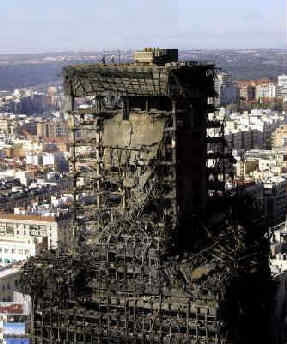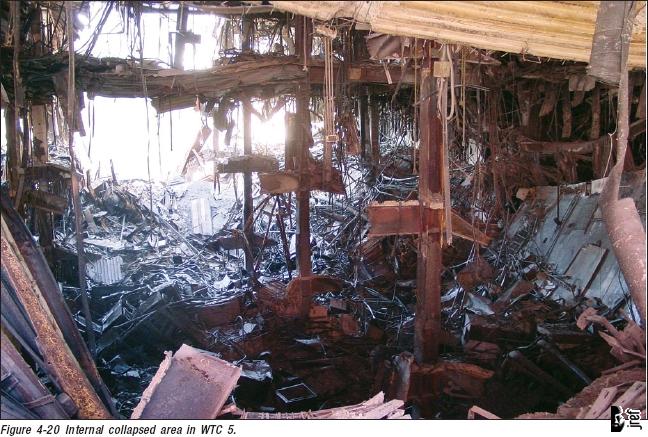On the debunkers thread, Heiwa has suggested that one of the underlying flaws in the NIST collapse report is the steelwork would be inherrently resistant to heat-induced failure under typical fire conditions.
The purpose of this thread is to provide Heiwa with an opportunity to post the evidence for this quite remarkable claim.
Just to kick things off, let's look at how steelwork responds to fire. Heiwa, I'd like you to tell me if there are any errors that I make. And be specific.
Testing Criteria
Firstly, the lay reader may be interested to learn that there are, of course, formal standards to test the fire performance of structural steelwork.
Hot finished carbon steel begins to lose strength at temperatures above 300°C and reduces in strength at steady rate up to 800°C. The small residual strength then reduces more gradually until the melting temperature at around 1500°C. This behaviour is similar for hot rolled reinforcing steels. For cold worked steels including reinforcement, there is a more rapid decrease of strength after 300°C (Lawson & Newman 1990). In addition to the reduction of material strength and stiffness, steel displays a significant creep phenomena at temperatures over 450°C. The phenomena of creep results in an increase of deformation (strain) with time, even if the temperature and applied stress remain unchanged (Twilt 1988).
High temperature creep is dependent on the stress level and heating rate. The occurrence of creep indicates that the stress and the temperature history have to be taken into account in estimating the strength and deformation behaviour of steel structures in fire. Including creep explicitly within analytical models, is complex. For simple design methods, it is widely accepted that the effect of creep is implicitly considered in the stress-strain-temperature relationships.
For those who require further information or, as the case may be, persuasion regarding the actual performance of steelwork under such conditions we are fortunate that a predictably large numbers of leading bodies have looked at the issue in depth.
http://www.shef.ac.uk/fire-research/..._meetings.html
http://www.corusconstruction.com/page_1416.htm
http://www.bfrl.nist.gov/866/CIB_W14/workprog.htm
http://www.civil.canterbury.ac.nz/fi...rts/KLewis.pdf
Note in particular the strength/temperature/yield grading charts in the final link, which have obvious implications for the structure of any steel framed building exposed to fire conditions.
Practical Implications - Design Codes and Building Regulations
air supply are considered.
The requirements and calculations so arising are necessarily complex.
As the reader might anticipate, because structural steelwork is at risk of failure in a fire building regulations also introduce fireproofing requirements.
The Scottish Regs, section D, are a bit detailed - http://www.scotland.gov.uk/build_regs/sect-d.pdf - but you'll notice do flag up the need for fire protection in structural components and steelwork.
In England, Part B of the Regs flags up a similar position - its not available on-line free but Corus (who do know a thing about steel) have a useful and relatively non-technical summary at http://www.corusconstruction.com/leg...s_section1.pdf . Some of you will note on page 5 the admission that most unportected steel sections only have fire integrity for about 15 minutes.
The Canadian Regs aren't available on-line free either, but their national buildings institute flags up across all their documents the risk posed by fire and the need for protection - see, by way of example, http://irc.nrc-cnrc.gc.ca/cbd/cbd071e.html .
The New Zealand and Australian steel codes, (SNZ, 1997 and SAA 1990) are very similar to each other. The NZ regs section C4 requires....wait for it......structural protection of steel in fire ( http://www.building.govt.nz)
Summary
It is recognised through empirical analysis across a recognised series of standards that structural steelwork weakens significantly under normal fire conditions, and as a consequence codes require additional protection through (for example) the incorporation of passive fire protection systems.
There is no evidence that such tests are wrong, or that fire protection can be safely omitted due to (for example) the efects of heat conduction throughout the affected members.
The purpose of this thread is to provide Heiwa with an opportunity to post the evidence for this quite remarkable claim.
Just to kick things off, let's look at how steelwork responds to fire. Heiwa, I'd like you to tell me if there are any errors that I make. And be specific.
Testing Criteria
Firstly, the lay reader may be interested to learn that there are, of course, formal standards to test the fire performance of structural steelwork.
The general procedures used for determining the fire resistance of load-bearing elements of structure are specified in BS476 series. In assessing the performance of fire protection materials the relevant parts are:
Part 20 Method of determination of the fire resistance of elements of construction (general principles)
Part 21 Method of determination of the fire resistance of load-bearing elements of construction
Whilst BS 476 Part 20 is concerned with general principles and covers requirements which are common to the other parts of BS 476, the BS 476 Part 21 fire resistance testing covers load-bearing elements of construction, such as steel beams, columns or walls, whilst BS 476 Part 22 fire resistance tests are intended for non load-bearing elements of construction.
European fire testing standards have also been published. In assessing the performance of fire protection materials the relevant part is presently ENV 13381-4 “Test methods for determining the contribution to the fire resistance of structural members Part 4: Applied protection to steel members”. This standard makes reference to the EN 1363 Series of standards which contain general information about conducting fire resistance tests. However, as all the procedures for assessing fire protection are currently specified in ENV13381-4, it is this standard which is generally referred to in this publication.
Performance of Steel in Fires
Hot finished carbon steel begins to lose strength at temperatures above 300°C and reduces in strength at steady rate up to 800°C. The small residual strength then reduces more gradually until the melting temperature at around 1500°C. This behaviour is similar for hot rolled reinforcing steels. For cold worked steels including reinforcement, there is a more rapid decrease of strength after 300°C (Lawson & Newman 1990). In addition to the reduction of material strength and stiffness, steel displays a significant creep phenomena at temperatures over 450°C. The phenomena of creep results in an increase of deformation (strain) with time, even if the temperature and applied stress remain unchanged (Twilt 1988).
High temperature creep is dependent on the stress level and heating rate. The occurrence of creep indicates that the stress and the temperature history have to be taken into account in estimating the strength and deformation behaviour of steel structures in fire. Including creep explicitly within analytical models, is complex. For simple design methods, it is widely accepted that the effect of creep is implicitly considered in the stress-strain-temperature relationships.
For those who require further information or, as the case may be, persuasion regarding the actual performance of steelwork under such conditions we are fortunate that a predictably large numbers of leading bodies have looked at the issue in depth.
http://www.shef.ac.uk/fire-research/..._meetings.html
http://www.corusconstruction.com/page_1416.htm
http://www.bfrl.nist.gov/866/CIB_W14/workprog.htm
http://www.civil.canterbury.ac.nz/fi...rts/KLewis.pdf
Note in particular the strength/temperature/yield grading charts in the final link, which have obvious implications for the structure of any steel framed building exposed to fire conditions.
Practical Implications - Design Codes and Building Regulations
The fire design codes BS 5950-8, Eurocode 3 Part 1-2 and Eurocode 4 Part 1-2 provide the framework for designers to calculate the temperature at which a given steel member will fail in a fire situation. These design methods incorporate more realistic estimates of the applied load during a fire and include the effects of non-uniform heating through and along the member. The design methods are based on either fire
resistance, which is a measure of an element to withstand given criteria in a standard furnace test, or natural fires where the size of the fire compartment, available combustible material, characteristics of the compartment boundaries and
resistance, which is a measure of an element to withstand given criteria in a standard furnace test, or natural fires where the size of the fire compartment, available combustible material, characteristics of the compartment boundaries and
air supply are considered.
The requirements and calculations so arising are necessarily complex.
As the reader might anticipate, because structural steelwork is at risk of failure in a fire building regulations also introduce fireproofing requirements.
The Scottish Regs, section D, are a bit detailed - http://www.scotland.gov.uk/build_regs/sect-d.pdf - but you'll notice do flag up the need for fire protection in structural components and steelwork.
In England, Part B of the Regs flags up a similar position - its not available on-line free but Corus (who do know a thing about steel) have a useful and relatively non-technical summary at http://www.corusconstruction.com/leg...s_section1.pdf . Some of you will note on page 5 the admission that most unportected steel sections only have fire integrity for about 15 minutes.
The Canadian Regs aren't available on-line free either, but their national buildings institute flags up across all their documents the risk posed by fire and the need for protection - see, by way of example, http://irc.nrc-cnrc.gc.ca/cbd/cbd071e.html .
The New Zealand and Australian steel codes, (SNZ, 1997 and SAA 1990) are very similar to each other. The NZ regs section C4 requires....wait for it......structural protection of steel in fire ( http://www.building.govt.nz)
Summary
It is recognised through empirical analysis across a recognised series of standards that structural steelwork weakens significantly under normal fire conditions, and as a consequence codes require additional protection through (for example) the incorporation of passive fire protection systems.
There is no evidence that such tests are wrong, or that fire protection can be safely omitted due to (for example) the efects of heat conduction throughout the affected members.
Last edited:





